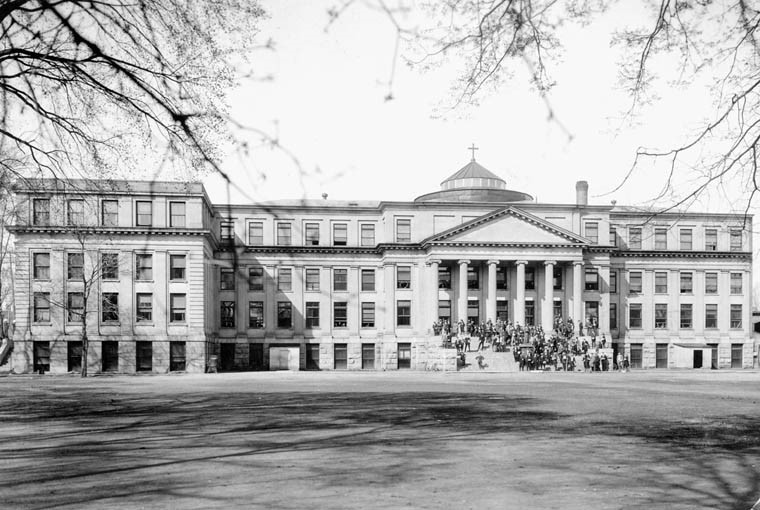The University of Ottawa occupies a large space in Sandy Hill, both physically and figuratively. The University traces its roots to 1848 when the Oblate Order founded the College of Bytown as a bilingual catholic school. The College was initially located on Guigues St. in Lowertown before moving in 1856 to what was then the outskirts of the city on Wilbrod St. (now Séraphin Marion), just west of Cumberland St. This land belonged to Théodore Besserer who sold it to the Catholic Diocese for £30 for the express purpose of establishing a school. Besserer probably expected this sale would make the development of his empty Sandy Hill estate more attractive to future residents. It is said that another condition of the deed was that all of Besserer’s descendants have the right to attend the College free of charge in perpetuity (Besserer fathered 13 children from two wives).
Forty years later at the turn of the 20th Century, the University was still small, with a little over 400 students, mostly at the high school level, as the university still combined secondary and tertiary education. Some 50 professors, most of whom were Oblates, taught the students who were all male. Academic fees seem very low by today’s standards ($30 in 1893) but were likely held down by the fact that the Oblate fathers did not earn a salary. The university was housed in a stone building on the south side of Séraphin Marion and included dormitories as well as classrooms as many students lived there in residence. A richly-decorated chapel, that could accommodate 1,000 worshippers, was added in 1887. The building was entirely destroyed by a great fire in 1903. Three people – two priests and a young female servant — died.
The University replaced this building in 1905 by what is now Tabaret Hall, named after Father Joseph-Henri Tabaret who led the University for over 30 years, including its transition from a college to a degree-granting institution. Tabaret Hall was designed in the Greek neo-classical style by New York architect A.O. Von Herbulis. The fenced-in green that is now in front of the building, however, only came in existence in 1967 as one of Canada’s Centennial projects when it replaced a parking lot.

Tabaret Hall, however, is not the oldest building on campus. That distinction belongs to the former Juniorat du Sacré Coeur (1894) at the corner of Cumberland St. and Laurier Ave. Now housing the department of visual arts, the Juniorat was for 70 years a high school for aspiring priests before the University bought it in 1970. While the big cross that crowned the building is long gone, the initials JSC can still be seen in wrought iron below the door facing Laurier Ave. The Academic Hall (133 Séraphin Marion) is also older than Tabaret Hall, dating to 1901. Originally a science building, its museum was changed into a performance hall in 1923, making it the oldest performing space still in use in Ottawa.
Sports, including hockey, have played an important role at the University since the 1870s. Frank Finnegan, the “Shawville Express”, who played for the Senators in the NHL in the 1920s, was a product of the University of Ottawa Gee-Gees. All of the University sport teams bear the same name, a name that comes from the initials of the team colours – grey and garnet.
The University retained a small footprint until the 1950s when it expanded south of Laurier Ave. unto what had then been residential streets[1]. The University today occupies the land between Henderson Ave. and Nicholas St. south of Laurier Ave. as well as the original Besserer land grant north of Laurier Ave. and also owns many adjoining properties. Its four campuses[2] cover 42.5 hectares and it is the largest bilingual (French-English) university in North America with over 43,000 students in attendance and an academic staff of almost 3,000. While demographic trends imply that it will not grow as quickly as it did after 2000, the University’s master plan imply big physical changes to the campus in the future, including the construction of several new buildings along King Edward Ave. south of Laurier Ave.
[1] It already owned the land south of Somerset St. and west of King Edward Ave.
[2] These are the main campus, the Lees campus, Roger Guindon (beside the Ottawa Hospital) and 99 Bank St.
